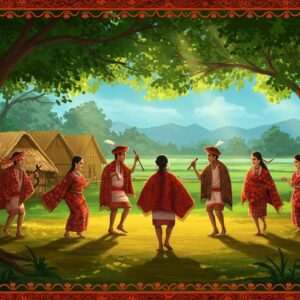Exploring Dashavatara: Telugu Culture and Traditions

Dashavatara, the ten incarnations of Lord Vishnu, holds profound significance in Telugu culture and traditions. These incarnations are not merely mythological tales but represent the continuous cycle of divine intervention to restore balance and righteousness in the universe. This blog delves into the importance of Dashavatara in Telugu culture, exploring its presence in festivals, art, literature, and daily life.
The term “Dashavatara” originates from Sanskrit, meaning “ten avatars.” In Telugu, it specifically refers to the ten incarnations of Lord Vishnu. These avatars appear whenever righteousness declines and unrighteousness prevails, ensuring the preservation of cosmic order and the protection of humanity.
- Lord Vishnu’s Role: He takes on the form of an avatar to restore cosmic balance and safeguard mankind.
- Significance of the Ten: The ten avatars of Vishnu are considered paramount, though variations exist.
The primary avatars of Vishnu, in order, are: Matsya, Kurma, Varaha, Narasimha, Vamana, Parashurama, Rama, Krishna, Buddha (or sometimes Balarama), and Kalki. These avatars hold cultural and religious significance within Telugu society and beyond, symbolizing the evolution of consciousness and the triumph of good over evil.
Dashavatara in Telugu Culture: A Deeper Look
Delving into the cultural significance of Dashavatara in Telugu traditions reveals a vibrant tapestry of stories, rituals, and artistic expressions. This section explores the multifaceted presence of these ten incarnations in various aspects of Telugu life.
Festivals: Dashavatara is woven into the fabric of Telugu festivals, such as Ugadi and Janmashtami. These celebrations become vibrant expressions of devotion, filled with stories and rituals that honor Lord Vishnu’s incarnations. You can find items for these festivals at poojn.in.
Art and Literature: Telugu art and literature are infused with depictions and narratives of Dashavatara. From traditional theater forms like Harikatha and Burrakatha to modern cinema and television, these stories continue to inspire and educate, passing down timeless wisdom and cultural values across generations. Browse our collection of Radha Krishna Murtis.
Daily Life: Dashavatara’s presence extends beyond grand celebrations and artistic representations, permeating daily life through prayers, stories, and family traditions. This constant reminder of Lord Vishnu’s incarnations reinforces cultural identity and spiritual values. Discover our range of Ladoo Gopal Murtis for daily worship.
Preserving the Legacy: Dashavatara in the Modern Age
In contemporary Telugu culture, Dashavatara themes find renewed expression through modern media, educational initiatives, and traditional crafts. These avenues ensure that these ancient stories remain relevant and continue to resonate with younger generations.
Modern Media: Telugu cinema and television often reimagine Dashavatara stories, making them accessible and relatable to a wider audience while preserving their cultural and spiritual essence.
Education: Educational institutions play a vital role in passing on these traditions, using engaging methods to introduce Dashavatara to younger generations. This helps ensure the continued appreciation and understanding of these narratives.
Traditional Crafts: The growing demand for traditional Telugu crafts featuring Dashavatara themes demonstrates the enduring appeal of these stories. These crafts not only offer artistic expression but also serve as tangible reminders of cultural heritage. Poojn.in supports this by offering a variety of puja items related to Dashavatara.
FAQs on Dashavatara
What is the significance of Dashavatara in Telugu culture? Dashavatara is deeply significant as it symbolizes the cyclical nature of divine intervention, upholding dharma and preserving cosmic order. It forms the core of many Telugu festivals, artistic expressions, and cultural narratives.
How are Dashavatara stories incorporated into Telugu festivals? Dashavatara stories are integral to festivals like Ugadi and Janmashtami, enriching celebrations with narratives of Lord Vishnu’s incarnations. These stories are brought to life through traditional performances, rituals, and communal gatherings.
Conclusion
Dashavatara remains a vibrant and dynamic force in Telugu culture, adapting to modern times while retaining its core spiritual and cultural significance. By embracing these traditions and supporting their preservation, we contribute to a rich legacy that continues to inspire and connect generations. Visit Poojn.in to find authentic puja items for your Dashavatara worship.


